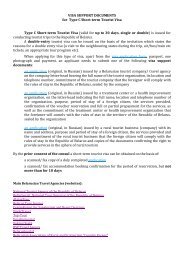Human Development Report 2013 - UNDP
Human Development Report 2013 - UNDP
Human Development Report 2013 - UNDP
You also want an ePaper? Increase the reach of your titles
YUMPU automatically turns print PDFs into web optimized ePapers that Google loves.
NotesOverview1 Atsmon and others 2012.2 Samake and Yang 2011.3 The demographic dividend isconsidered a window of opportunityfor additional economic growth whenthe proportion of the working-agepopulation increases. As fertilitylevels fall in a demographic transition,the number of children declineswhile the working-age populationincreases, lowering the dependencyratio. A country can reap the benefitsof increased productive capacityassociated with the lower proportionof dependents. As fertility levelscontinue to decline, however, dependencyratios eventually rise with theincrease in retired workers.Introduction1 According to World Bank (2012a),the average GDP growth rate in2009 for high-income membersof the Organisation for EconomicCo-operation and <strong>Development</strong> was–3.9%, compared with 7.5% in EastAsia and Pacific, 7.4% in South Asia,3.6% in the Middle East and NorthAfrica and 2.1% in Sub-SaharanAfrica.2 According to Maddison (2010), GDPper capita (in international dollars)rose from $1,250 in 1700 to $2,330 in1850 in the United Kingdom and from$1,257 in 1820 to $2,445 in 1870 inthe United States.3 Atsmon and others 2012.4 In addition to increased votingshares and senior appointments atthe International Monetary Fund andthe World Bank, in recent years, theSouth has held leadership positions atthe International Labour Organization,the World Health Organization,the World Trade Organization andthe World Intellectual PropertyOrganization.5 Chen and Ravallion (2012) using the$1.25 a day poverty line.6 For example, in 1990, Uganda’s HDI(0.306) was comparable to that ofBenin, Central African Republic andGambia. By 2012, Uganda’s HDI hadincreased to 0.456, a substantialimprovement compared with itspeers (and statistically significantat the 95% level). Benin’s increasedfrom 0.314 to 0.436, Central AfricanRepublic’s from 0.312 to 0.352 andGambia’s from 0.323 to 0.439.7 In purchasing power parity terms, thestandard GDP and GNI calculus in<strong>Human</strong> <strong>Development</strong> <strong>Report</strong>s.8 Japan is not included in the long-termhistorical comparison between theother Group of Seven economies andBrazil, China and India because itdid not industrialize until late in the19th century and did not emerge as amajor world economic power until thesecond half of the 20th century.9 In current US dollars.10 Proportion of the population livingon less than $1.25 a day (in 2005purchasing power parity terms), accordingto World Bank (2012a).11 Estimates refer to years between2002 and 2011.12 The measures used—life expectancyand mean years of schooling—haveupper bounds towards which developingcountries tend to eventuallyconverge. There is no upper thresholdof convergence for income.13 HDRO calculations based onBrookings Institution (2012). Themiddle class includes people earningor spending $10–$100 a day in 2005purchasing power parity terms.14 Dobbs and others 2012. Ali andDadush (2012), using car ownershipas a proxy for the middle class, suggestthat there are up to 600 millionpeople in the middle class in thedeveloping G20 countries, about 50%more than previous estimates byMilanović and Yitzhaki (2002), whocounted people earning $10–$50 aday in purchasing power parity termsas belonging to the middle class.15 <strong>UNDP</strong> 2009; World Bank 2010a.16 UNCTAD 2010.17 Zuckerberg 2012.18 Estevadeordal, Frantz and Taylor(2003); the trade to GDP ratio is thesum of exports and imports of goodsand services divided by total output.19 The current trade ratio is a five-yearaverage from 2006 to 2010, obtainedfrom World Bank (2012a).20 Hamdani <strong>2013</strong>.21 Heilmann 2008.22 United Nations 2012a.23 United Nations 2012a.24 Based on data between 2005 and2008 from Kharas, Makino and Jung(2011) and extrapolation thereafter.Chapter 11 This is in nominal terms. In purchasingpower parity terms, the share isabout 46%.2 IMF 2011b.3 Iley and Lewis (2011); see also IMF(2011b).4 HDRO calculations based on dataon general government expenditureon social protection fromthe Organisation for EconomicCo-operation and <strong>Development</strong> showthat some industrialized countries,including Australia, Austria, Denmarkand Norway, increased expenditureon social protection between 2007and 2010.5 For some countries confronting highdebt levels (such as Greece, Italy andJapan), the subprime crisis spiralledinto a sovereign debt crisis, leavinglittle fiscal space to postpone fiscalconsolidation. Holland and Portes(2012) suggest that, while in normaltimes fiscal consolidation wouldlower debt to GDP ratios, under currentcircumstances, in the EuropeanUnion, it will likely lead to higher debtto GDP ratios in the region in <strong>2013</strong>,with the exception of Ireland.6 Guajardo, Leigh and Pescatori 2011.7 ILO 2012.8 Sen 2012.9 Keynes 1937.10 ILO 2012.11 Throughout the crisis, the solutionsimplemented (such as fiscal consolidationand easy monetary policies)have been criticized for reaching theirlimits, for their secondary effects andfor their transitory nature. In somecountries, the solutions have causedthe economy to contract, and inothers, they have pushed short-terminterest rates in key money marketsclose to zero. These policies run therisk of creating new asset bubblesand exporting inflationary pressuresto countries in the South. See Naqviand Acharya (2012 , pp. 11–12) formore detail.12 IMF (2011b, p. 29) points out that“emerging and developing economiesaccount for about half of global outputand two-thirds of global growth inpurchasing power parity (PPP) terms.”Moreover, it argues that although theshare of emerging and developingcountries’ consumption (measured asconsumption in constant US dollars,not as GDP in purchasing power parityterms) does not make up for the lowerconsumption contribution of advancedeconomies on their own, it is largeenough to rebalance when combinedwith US (or European) consumption.13 HDRO calculations show thatcountries as disparate as China andthe United States have benefited inthe long term from government investmentin health and education (seechapter 3 for more details).14 Given by the ratio of GNI per capitafor Seychelles ($22,615) and theDemocratic Republic of Congo ($319).15 HDRO calculations based on Burd-Sharp and Lewis (2010).16 These disparities are of a similarorder of magnitude as the disparitybetween the HDI values of, say,Mexico (0.78) or Ecuador (0.72)on the one hand, and Nigeria,Senegal or Mauritania (0.47), on theother. Subnational HDI values are notdirectly comparable with nationalHDI values because they consist ofdifferent indicators and are for differentyears.17 These disparities are of a similarorder of magnitude as the disparitybetween the HDI values of Belgium(0.90), on the one hand, and Hondurasor Kiribati (0.63), on the other.18 Based on a balanced panel comparisonand data from World Bank(2012a).19 Since income is a flow variable andeducation and health outcomes arestock variables, sometimes a positivedifference between GNI per capitaand HDI rank can emerge when acountry has built up its developmentachievements but its income falls inthe short term (as in Zimbabwe).20 United Nations 2012a.21 World Bank 2012a.22 United Nations Enable 2012.23 Sen 2007.24 Smith 1776.25 <strong>UNDP</strong> 2011a.26 Estimates refer to years between2002 and 2011.27 World Bank 2012b.28 See, for example, Wilkinson andPickett (2009).29 Inequality in the HDI components ismeasured by the Atkinson inequalityindex, which takes into accountinequality in distribution within andacross groups consistently. In addition,it puts more weight on the lowerend of the distribution, thus accountingfor child mortality, illiteracy andincome poverty better than the Ginicoefficient.30 OECD (2011b) shows that in thecontext of Organisation for EconomicCo-operation and <strong>Development</strong>Notes | 125
















